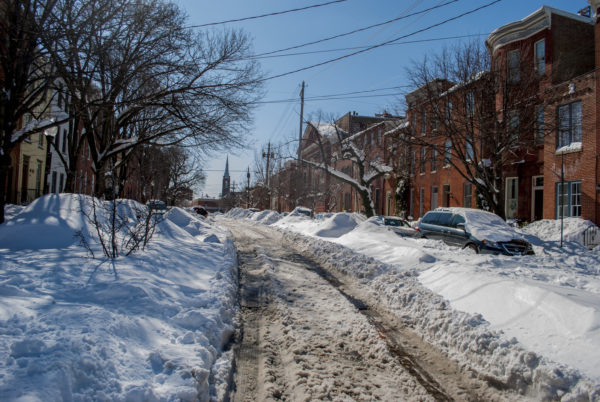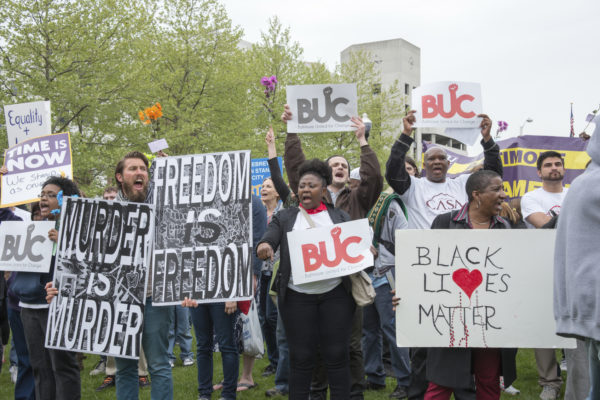Governing Perma-Austerity in Baltimore
Madeleine Pill reports on the findings from the exploratory research in Baltimore, carried out as part of the Collaborative Governance under Austerity project, sponsored by the Economic and Social Research Council as part of its Urban Transformations Network, and led by Prof. Jonathan Davies.

The City of Baltimore has 621,000 residents, a quarter of whom are below the poverty line (US Census 2010). An extract from the outgoing Mayor’s 2013 State of the City speech helps set the scene – ‘for over 50 years, Baltimore’s story has been dominated by a narrative of post-industrial decline. From 1950 to 2000, the city lost a third of its population. Jobs disappeared, crime rates rose, schools deteriorated, and many neighbourhoods destabilised. City government itself was left with a legacy of high taxes, growing liabilities, and crumbling infrastructure’.
Initial research interviews confirmed that Baltimore ‘is used to austerity and functions like that all the time’. The city’s longstanding ‘culture of scarcity’ is linked more to the ‘de facto devolution’ of Reaganomics than the 2008 crisis, which is not regarded as a significant turning point for the city. Its ‘fiscal squeeze’ had already resulted in deployment of the standard repertoire of measures (such as a city hiring freeze and pension and health benefit reform for city agency workers). Only a minority of those interviewed saw these as political choices, the majority seeing them as part and parcel of the ‘muddling through’ required out of perceived necessity.
The City of Baltimore’s approach to its ongoing challenges has been to find ways to increase revenue and reduce public spending; partner with key local institutions to try to integrate systems and approaches; focus on economic development; and seek to attract and retain people to live in the City through a focus on neighbourhoods. The latter policy realm of neighbourhood revitalisation/ community development formed the focus for exploratory research in the city. Here the city’s ‘ed and med’ anchor institutions and its philanthropic foundations are key players, along with city government.
The strategies and tactics with neighbourhood implications include:
- A Housing Typology was adopted by the City of Baltimore in the early 2000s as an asset- (rather than need) based way of prescribing policies and prioritising city resources for its neighbourhoods. The typology prioritises neighbourhoods ‘in the middle’ (where interventions are perceived as being able to help the market). However, at the time of research the emphasis on the city’s ‘stressed’ neighbourhoods (with the policy prescription of demolition for site assembly) was boosted by significant funding for a 4,000 property demolition and redevelopment initiative from the State of Maryland.
- “Change to Grow” is the title of the city’s fiscal plan (adopted in 2013), which seeks to address the city’s deficit and shows that city strategies are predicated on the need to deconcentrate poverty by (both retaining and) attracting the middle class to the city through better services, a better quality of life and less ‘fiscal stress’ . Achievement of this ‘meta-goal’ is linked to what a Community Development Corporation director described as Baltimore’s ‘niche’ providing a ‘low-cost [housing] alternative in a high-cost region [which] goes from Washington to Boston’. This approach sustains the focus on neighbourhoods in ‘the middle’.
- “OutcomeStat” is an emergent strategy, based on the principles of Results-Based Accountability, presented by city officials as a way of seeking to align non-profit and philanthropic initiatives and resources with those of city government by combining them in an outcomes-based methodology, using indicators grouped under (Mayoral) priority outcomes. Such approaches may herald the upscaling and rationalisation of the city’s non-profit organisations.
- Self-help and self-provisioning of services in those neighbourhoods containing the necessary voluntary associative capacity is longstanding practice in Baltimore, where city government is challenged to provide ‘the basics’.
- Urban boosterism of the downtown, waterfront area continues the pattern set in the 1950s and most famously realised in the 1980s Inner Harbor redevelopment. New downtown investment includes the current $1.8 billion Harbor Point waterfront development, which has received significant public subsidy via tax credits, which are also being sought for another significant development at planning stage, Port Covington.
Funding scarcity was linked by everyone interviewed to the need to work together. The notion of ‘integration’ was widely used, linked to the rising policy realm of workforce development. This has been championed by the city’s philanthropic and anchor institutions (acting through and assisted by the Baltimore Integration Partnership), and spurred by Johns Hopkins University and Medical System with its HopkinsLocal initiative. City government adoption of the Baltimore City Anchor Plan (2014), through which anchor institutions regularly meet by geographic sector, underlines this joint working, though it was stressed by some that the anchors set the direction, ‘we do our own thing and the City kind of follows along with us’.
But where’s the citizen? In discussing working together, citizens/ service users/ community representatives were not generally mentioned, partnership interpreted as being between the city’s key institutions and its non-profit organisations. A government official critiqued the ‘whole infrastructure… [that] co-opts community voice and says, this is what the community wants’. The absence of the citizen in these informal governing arrangements belies a European-style ‘collaborative moment’ in the city.
However, the riots which took place in the city in April 2015 in response to police brutality and misconduct proved to be a key focusing moment which was emphasised by all those interviewed. A community activist explained that ‘the unrest awakened many people’ who are ‘talking about things they’ve never talked about before’. Another commented, ‘it’s going to take courage…because these are systematic, inequitable things that are so entrenched in this city that we really have to blow this thing up and do it the right way’.

Another priority for the current interviews is to talk to citizen activists and informal community leaders. In the exploratory phase we found that the social movements and civil society activism obvious in the city are motivated by a deep sense of injustice – especially with regard to policing and housing. We will explore what people mean by social justice in the city, and the similarities and differences between current protests against injustice and those of the 1960s. Are the injustices the same or are there new spatial and economic inequalities? We will explore whether a socially just Baltimore is possible and what local actors are seeking to and can achieve in this regard. For example, one convening body explained that it had discussed structural racism and the challenge of ‘how it translates, how it gets funded or how more youth get engaged’. Also, what is the potential for local political change? For example, a national voice in Black Lives Matter, DeRay McKesson, sought (unsuccessfully) to gain the Democratic nomination for Mayor of Baltimore this April, but his candidature does indicate a ‘grassroots, community-driven, young, energetic constituency that is starting to gain momentum and have a voice’.
The research coincides with a particularly turbulent period of change in political leadership at federal as well as city level, ‘the Governor is still going to be here next year. Our Mayor is not… we also don’t know who’s going to be president next year’. What happens at Federal level remains to be seen. However, the bounded and devolved nature of city governance in the US means that Baltimore provides a rich case in which to explore the local particularities and responses to challenges experienced to a greater or lesser degree across all eight of the cities in this project.
Dr Madeleine Pill is Lecturer in Public Policy at the University of Sydney This blog was originally posted on the Centre for Urban Research on Austerity’s website.